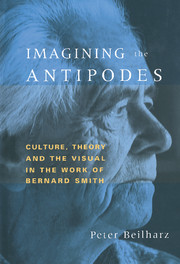Book contents
- Frontmatter
- Contents
- Preface
- Introduction
- Chapter 1 Beginnings
- Chapter 2 Encountering Australian Painting
- Chapter 3 Imaging the Pacific
- Chapter 4 The Antipodean Manifesto
- Chapter 5 Death of the Hero as Artist
- Chapter 6 Modernity, History and Postmodernity
- Chapter 7 Conclusions – Imagining the Antipodes
- Notes
- Index
Chapter 2 - Encountering Australian Painting
Published online by Cambridge University Press: 22 September 2009
- Frontmatter
- Contents
- Preface
- Introduction
- Chapter 1 Beginnings
- Chapter 2 Encountering Australian Painting
- Chapter 3 Imaging the Pacific
- Chapter 4 The Antipodean Manifesto
- Chapter 5 Death of the Hero as Artist
- Chapter 6 Modernity, History and Postmodernity
- Chapter 7 Conclusions – Imagining the Antipodes
- Notes
- Index
Summary
PLACE, TASTE AND TRADITION
‘In 1940 no one in Sydney took any real interest in Australian art.’ Thus wrote Smith in the opening lines of the Second Preface to his first history of Australian art. Written into 1944, it was first published by Sidney Ure Smith in 1945. Out of print for years, it was finally reprinted by Oxford University Press in 1979. In the 1979 Preface Smith surveyed the interim period. Looking back, the indifference about Australian work is difficult to imagine. By our own times, of course, Tom Roberts jostled with Ken Done in postcard racks, and Fred Williams had joined Sidney Nolan as a national iconographer; even Juan Davila might periodically show up in public places. The situation Smith entered was a silence unto death. William Moore's Story of Australian Art of 1934 had been remaindered two years after publication. Smith viewed it as a fairly important achievement in its context; he blamed the soil on which it fell. These were not good times. Along with Lot and Pompeii Smith had completed in 1940 another painting, Drought, which also showed up in the 1993 Surrealism show. It was an Australian landscape executed perhaps under the influence of Eliot's Waste Land. While the Nazis were destroying art by fire in Germany, meantime, the philistines and phoneys in Australia always looked elsewhere when they heard the word ‘art’. The Sydney scene was a waste land as well. All the same, Moore's book made clear to Smith his own ignorance.
- Type
- Chapter
- Information
- Imagining the AntipodesCulture, Theory and the Visual in the Work of Bernard Smith, pp. 27 - 62Publisher: Cambridge University PressPrint publication year: 1997



